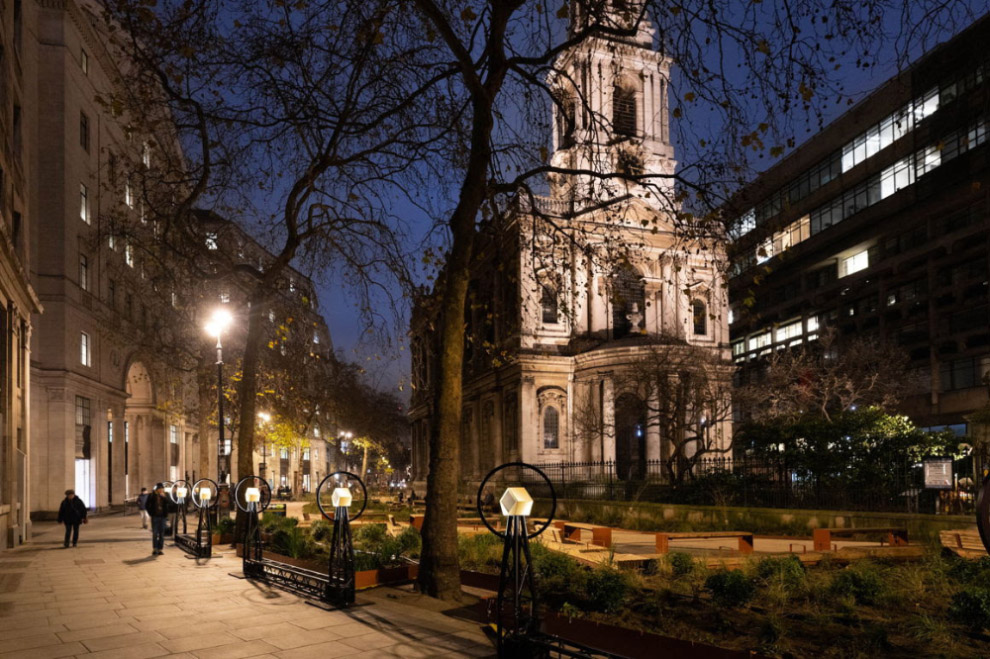The VoiceLine, a creation of sound artist Nick Ryan in celebration of the 100th anniversary of the first radio transmission of the BBC that provides immersive audio along a pedestrianized stretch of The Strand in Central London’s City of Westminster, utilizes nearly 40 L-Acoustics 5XT coaxial loudspeakers driven by LA4X amplified controllers that are fed programming often optimized in the L-ISA Studio platform.
Ryan was among 15 artists who were asked to submit proposals for a commemorative art installation designed to foster the exchange of ideas, education, and art appreciation in the well-traveled common space. The aim was to “take back” an area that was congested with traffic and noise pollution by converting it into a culturally inviting space that would appeal to the millions of people who visit the area each year.
“I proposed the idea of a sound installation, and I was the only artist that suggested sound,” Ryan recalls. “It was very interesting because the area had been known for noise, not sound,” noting that St Mary le Strand — a church located smack in the middle of the Strand thoroughfare — was designed 300 years ago with no windows on the ground floor because even then, processional traffic had been so problematic.
“My idea was to use sound in a controlled way,” Ryan adds. “Rather than changing it once every 300 years, I wanted the soundscape to change every second or every minute, and use a long, very sophisticated speaker array to animate the space through sound.”

After creating and testing several prototypes, Ryan created a linear sound array featuring 39 L-Acoustics 5XT coaxial loudspeakers, each located 3-1/2 meters apart and set along a path within the newly pedestrianized quarter. Powering the array are 10 L-Acoustics LA4X four-channel amplified controllers, each connected to an AVB network where they can be independently controlled.
Ryan is one of 70 artists in residence at London’s Somerset House, a former Royal Palace that has been transformed into a centrifuge for creativity and the arts. Located directly across the street from Somerset House, pedestrians can enter The VoiceLine at any point along the 170-meter path and experience bespoke soundscapes throughout the day and into the evening. The installation is also features customized brass enclosures that Ryan designed to enhance the visual aesthetic while protecting them from the elements. Encircling each brass enclosure is a “light ring” that lights up whenever a sound emanates, providing a visual cue for the experience. “At night, they light up, indicating the behaviour of the sound and they look really beautiful,” says Ryan.
Since The VoiceLine opened, Ryan has experimented with several different customized soundscapes. Recorded material originates from a variety of possible sources, including his own sound library of environmental recordings and compositions, other commissioned artists’ work, the entire BBC Audio Archive, more. The programming schedule itself is driven by several factors, including the time of day and the context of typical pedestrian traffic. “One use case is that a pedestrian may start at one end and walk the entire route; we can exploit that journey in narrative form,” he says. “Some programs move at walking pace, and other pieces of music travel up and down the path quite rapidly.”
Examples of content that visitors may hear along the journey include “theatreland,” consisting of cast recordings Ryan has made during “Mamma Mia” warm-ups, and espionage broadcasts over strange frequencies during the last 50 years. “As it gets darker, we can get more experimental,” he observes.
In several of his VoiceLine broadcasts, Ryan has employed L-ISA Studio to give an added measure of control — particularly over elements such as panning and reverb. “VoiceLine is basically the unfolding of an immersive system into a line, and L-ISA Studio was instrumental in making the experience seamless. The idea is to create a ‘bubble of sound’ that precisely overlaps each subsequentbubble of sound, and L-ISA Studio helps me render this seamlessly.
The loudpeakers are positioned in a “crisscross” fashion and played at a relatively low level, so there is no break in the linearity. “We get a very high-fidelity sound from the L-Acoustics speakers and using these in combination with the L-ISA Studio software, the fixed points of each speaker become imperceptible. The perfect overlap between each sound source makes it a continuous experience.”

When he is composing and mixing some of the more challenging pieces broadcast across The VoiceLine, Ryan adds space and dimension using L-ISA Studio: “I love the immersive reverb,” he says. “If I had time, I would use that reverb for everything because it gives this incredible richness to any sound source. It is genuinely modeled, and it sounds so different,” he says. Ryan also appreciates the software’s powerful panning and rotation faculties: “Movement from one speaker to the next is seamless, and the rotation function can be very useful when you want to move an object a full 180 degrees — this capability doesn’t exist in other immersive tools.”
One of Ryan’s favorite pieces to play through The VoiceLine system is a quadraphonic recording of a family of whales made by his colleague Michelle Fournet, a marine acoustic ecologist. The pair collaborated on “Fathom,” film about how humpback whales communicate, and Ryan subsequently received an Emmy for his sound design work. “I’ve unfolded those whale recordings in L-ISA Studio, put a church reverb on them, and I have Michelle’s narration with no reverb in the middle speaker — it sounds incredible. Her voice is really clear, and you can hear it without any comb filtering, even though the same signal is coming out of five speakers on either side. Then there are these whales swimming around, making their noises down a line of eight along the street. It is incredible.”
The VoiceLine runs through April 17, 2023 and is free and open to the public between 8 am and 8:00 pm daily.




















